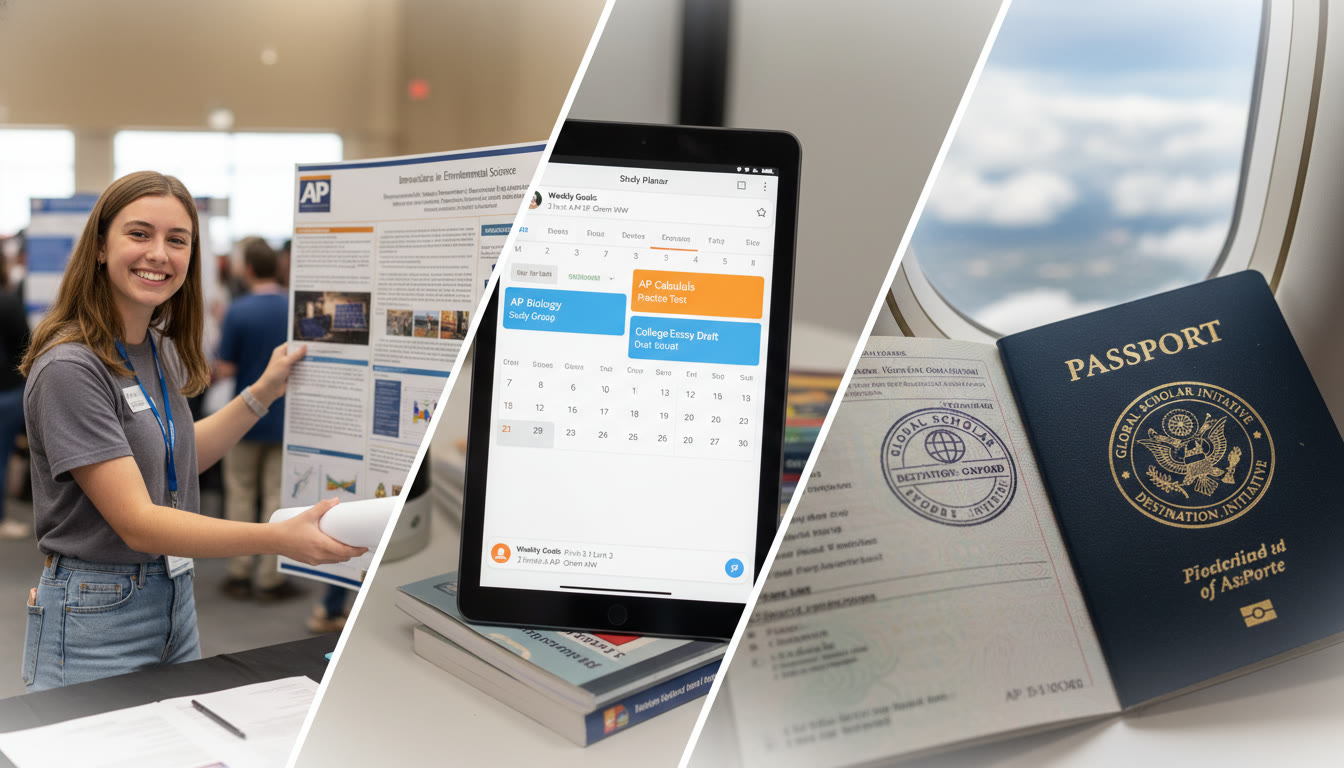Why Students Take a Gap Year — and Why AP Changes the Game
When you picture a gap year, you might see backpacking across Europe, volunteering abroad, or interning at a startup. Those are all great visions — but if you’ve invested time and energy into AP courses and exams, a gap year becomes a little more strategic. AP classes can deliver college credit, advanced placement, and a stronger application. So when you step away from the classroom for a semester or a year, you’ll want to do it with your AP work intact and your future plans clear.

The emotional case: rest, discovery, and maturity
College admissions and classroom competition can burn students out. A gap year offers breathing room: time to recharge, test interests in the real world, build confidence, and return to studies with clearer purpose. That renewed focus can make subsequent college study more intentional, and AP experiences you’ve already earned can help you jump ahead academically.
The practical case: credits, placement, and preparedness
AP Exam scores can translate into college credits or advanced placement in many schools — so preserving those scores and understanding how your target colleges treat them matters. A smart gap year plan keeps AP credit usefulness intact while using the year to add resume-worthy experiences.
Pros of Taking a Gap Year After AP
Let’s map out the upside. These are the reasons students with AP backgrounds often choose a gap year.
- Recharge and avoid burnout: After AP workload and college apps, a structured break prevents academic fatigue.
- Explore majors and careers: Internships, job shadowing, or community projects reveal whether your AP interests match long-term goals.
- Make AP credits count: If you’ve secured strong AP scores, you can use the year to plan which credits to apply and how to best schedule your first semester in college.
- Develop soft skills: Leadership, cross-cultural communication, and time management are easier to gain in real-world settings than in a textbook.
- Strengthen applications: Colleges value purposeful gap years when they’re well-explained and add depth to your profile.
Cons and Risks — What Could Go Wrong
Gap years are powerful but not risk-free. Outline these pitfalls so you can mitigate them before you step away.
- Loss of academic momentum: Without structure, some students return rusty on study habits.
- Credit confusion: Not every college grants AP credit the same way; policies change and require checking.
- Financial and logistical costs: Travel, unpaid internships, or programs can be pricey unless you budget carefully or find paid work.
- Admissions miscommunication: If you don’t follow your college’s gap year process (deferral requests, communication), you risk losing your spot.
- Opportunity costs: For some, delaying college can delay scholarships or access to on-campus opportunities that are time-sensitive.
Logistics: How to Keep AP Credits and Placement Intact
Here’s a step-by-step approach you can follow to keep AP benefits while taking a gap year.
1. Confirm your AP scores and how they map to college credit
After AP Exam season, your scores are released. Colleges have their own credit and placement charts — some award credit for scores of 3, others require 4 or 5 for particular courses. Before you commit to a gap year, create a spreadsheet that lists:
| Item | Action |
|---|---|
| AP Scores | Collect official score report and note the scores for each exam. |
| Target College Policy | Check credit/placement policy for each college you’re considering. |
| Application Timeline | Confirm deferral or gap year acceptance policies and deadlines. |
| Score Send | Plan when to send score reports and to which institutions (remember free sends may have a deadline). |
Having this mapped prevents surprises. If a college requires official score submission by a certain date, make sure you meet it — or arrange to send scores after you take your gap year, if possible.
2. Apply, defer, or request a gap year properly
Most colleges allow admitted students to request a deferral or approved gap year. Policies vary: some require a formal plan, an application to defer, and a deposit to hold the spot. Treat this like a mini-application: be specific about your goals, how the year is structured, and how it prepares you for college-level work.
3. Send AP scores strategically
Think about when and where to send scores. Some students send scores right away to claim credits, while others wait and send them after the gap year when they finalize enrollment. Plan carefully to align with financial aid or scholarship deadlines — you don’t want a delay to affect your aid.
Designing a Gap Year That Builds on AP Strengths
A gap year that complements your AP background can be more than a break — it can amplify the benefits of your AP work.
Education-focused options that pair well with AP
- Teaching assistant roles: Use your AP subject knowledge to tutor or teach—great for demonstrating mastery and leadership.
- Research internships: If you took AP Biology, Chemistry, Physics, or Statistics, a lab internship strengthens your scientific credentials.
- Community college courses: Taking a semester of college classes during your gap year can keep you academically sharp and boost transfer credits.
- Structured global programs: Gap-year programs with intentional learning goals (language immersion, civic projects) convert experience into skill evidence on applications.
Work and life experience that complements AP
Paid internships or part-time jobs develop responsibility and real-world context for classroom concepts. For example, AP Economics plus a micro-internship at a local business lets you connect theory to practice — something admissions officers notice when well-articulated in essays.
Study and Exam Prep During a Gap Year
If you plan to take AP Exams during or after a gap year — or want to stay sharp for future coursework — build a study rhythm into your plan.
Practical study setup
- Create weekly goals: 6–10 hours per week of focused study for subjects you want to maintain.
- Use mixed practice: combine content review with practice questions and full-length timed sections.
- Keep a quiet study space: even while traveling, reserve a few consistent hours for deep work.
Personalized support can make this easier. Sparkl’s personalized tutoring offers 1-on-1 guidance, tailored study plans, and AI-driven insights that help you stay on track while your life is in motion — useful if you’re managing travel or work alongside AP prep.
Real-World Examples and Scenarios
Imagine two students who took AP courses, both considering a gap year. Their choices show the variety of outcomes.
Case A: Maya — Gap Year With Focused Academics
Maya scored 4s and 5s on her AP exams and deferred to her top-choice college for one year. She spent the year taking community college courses in calculus and creative writing, worked part-time at a tutoring center, and volunteered at a local museum. Returning to campus, she placed out of introductory classes and enrolled directly into intermediate-level courses. Her gap year produced letters of recommendation, a refined major choice, and an easier transition to college-level study.
Case B: Carlos — Gap Year of Exploration
Carlos used his gap year to work in a tech internship and save money. He also traveled regionally to conduct informational interviews in fields he was curious about. He didn’t take formal classes, but he continued occasional AP-style study to stay sharp. When he entered college, he used his AP credits for placement and leveraged job experience to land on-campus internships sooner than many peers.
How to Explain Your Gap Year to Colleges
Admissions officers and future employers want to see intention. Write and speak about your gap year as a year on — not a year off. Use measurable examples, like the hours you volunteered, projects completed, or coursework taken.
- Be specific: list projects, outcomes, and lessons learned.
- Connect to future goals: explain how the year informs your intended major or career path.
- Show learning: reference books read, formal courses taken, or skills gained.
Budgeting and Financial Considerations
Gap years can be free or expensive depending on your plan. If finances are a concern, consider paid internships, local volunteer roles with housing provided, or saving money by working full time. Keep an emergency fund — things rarely go exactly to plan, and financial flexibility reduces stress.
| Cost Element | Low Budget Option | Mid/High Budget Option |
|---|---|---|
| Housing | Live with family or host with friends | Rent, program housing, homestays |
| Travel | Local travel via bus/train | International flights, guided programs |
| Program Fees | Volunteer placements with minimal fees | Structured gap-year programs with tuition |
| Income | Part-time work, freelancing | Paid internships, contract roles |
Checklist: Before You Leave and Before You Return
Use this checklist to reduce friction. Treat your gap year like a project with milestones.
- Before you leave:
- Confirm college deferral/gap-year approval in writing.
- Map AP scores to credit/placement at your college(s).
- Send any required official scores or plan exact dates for sending them later.
- Make a budget and emergency fund.
- Outline learning goals and document how you’ll measure success.
- During your gap year:
- Keep a weekly log of activities, hours, and reflections.
- Stay connected to academic practice — even short weekly study sessions help.
- Gather artifacts: photos, project deliverables, references, and letters.
- Before you return:
- Confirm enrollment logistics with your college (housing, orientation, advising).
- Send any remaining official score reports needed for credit.
- Prepare a short narrative you’ll use in orientation or early advising to explain your gap year and goals.
How Tutoring and Personalized Support Fit In
A gap year isn’t an all-or-nothing choice between academics and experience. If you want to keep your AP momentum, targeted tutoring can maintain and deepen your subject mastery. One-on-one tutoring, tailored study plans, and AI-driven insights let you study efficiently and focus on weak spots. Many students balance a busy gap year schedule with weekly tutoring sessions that keep their academic muscles strong without dominating the year.
Sparkl’s personalized tutoring can be especially helpful here: tutors create study plans that fit travel, work, or volunteer commitments; they provide practice materials and feedback that mirror the rigor of AP assessments; and AI-driven insights identify the most impactful study moves so you spend less time guessing and more time learning.
Decision Time: Is a Gap Year Right for You?
Ask yourself these questions honestly:
- What do I want to learn or accomplish in a year that I can’t during college?
- Can I structure the year and commit to milestones?
- Do I have a plan for preserving or applying AP credits and a timeline for score submission?
- Will taking a gap year help me enter college more focused, or will it likely derail momentum?
If your answers lean toward intentional, goal-driven outcomes, a gap year can be a powerful bridge between high school and college. If not, consider a shorter break, summer options, or focused projects that deliver similar benefits without a full-year pause.
Parting Advice: Treat the Gap Year Like a Course
A gap year is most valuable when approached with the same discipline you’d use for AP study. Set clear learning objectives, create measurable outcomes, and document everything. Whether you use the time to study, work, travel, or volunteer, you’ll return to college with a richer story and sharper goals — and your AP work will remain an asset rather than a relic.

Quick Resources to Keep in Mind
Before you go: confirm deferral policies, check AP credit and placement rules at your college, and decide when to send official AP scores. While you’re away: maintain a study schedule, gather documentation, and log achievements. Before you return: finalize official score sends and use your gap-year experience to write sharper personal statements or elevator pitches for internships.
Final Thought
A gap year and AP success aren’t mutually exclusive — they can be deeply complementary. When planned well, a gap year turns AP achievements into springboards for deeper learning, stronger college placement, and a more confident start to campus life. Keep your plans practical, your goals specific, and your storytelling honest: the gap year you design now could become your strongest asset later.
Need help turning this into a personalized plan? Consider tutoring and planning support to keep your AP strengths intact while you explore. With the right guidance, your gap year can be a year of growth, clarity, and momentum.




















No Comments
Leave a comment Cancel